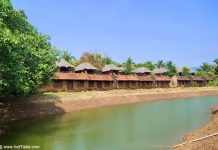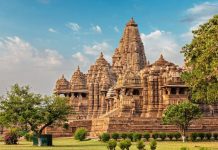If you ever had doubts about the fact that the universe conspires to make things happen for you, read this post. I was in Yogyakarta and we were to go to Borobudur early morning next day for sunrise. Just tweeted about it and Naren Ramakrishna (@NarenMenon1) on Twitter insisted that I also visit the Prambanan temple complex. He told me it is just 20 mins away and I can do it in as little as 2 hours. I did a basic search and spoke to our hosts in Indonesia. It was a long day and I do not know how things fell into place. On my birthday, I had done Borobudur in the morning and by afternoon I was standing in front of the temple complex with fellow bloggers from Australia, New Zealand, and Indonesia.

Now I had a vague idea about it, but I made it up by reading about it while we were driving to the temple. We had a bit of adventure when I ended up buying a domestic tourist ticket instead of an international one. I would later learn that an International ticket is 10 times costlier but it comes with Coffee. As luck would have it, I just had my first local coffee just outside the temple complex and it was Yum.
Prambanan Temple Complex

The enormity of the temple complex hits you when you start walking toward it. The three tall temple shikhara tower above the rest of the ground. Other temples are dwarfs in comparison. As you move closer you see a lot of rubble – all in dark gray stone. The rubble is obviously of the temples that once stood in this complex.
As per legends, there were 999 temples in the complex. However, architectural evidence suggests 240 temples.
The temple design follows the Sri Yantra formation with a Shiva temple in the middle flanked by Brahma and Vishnu temples. Each of these temples has a Vahana temple dedicated to their respective vahanas Nandi Bull, Hams & Garuda. There are two temples between the Brahma & Hamsa temple and between Vishnu & Garuda temples. These are called Apit temples. My Indonesian friend said that Apit means in between – but I have no clue who these temples are dedicated to.
Of these, 3 main and the largest temples belong to the Trimurti of the Hindu pantheon of Gods – Shiva, Brahma & Vishnu. In the middle stands the Shiva temple that was called Shivagriha or Shivalaya, both meaning the abode of Shiva.
Trimurti Temples at Prambanan
Let me walk you through the 3 main temples at the complex.
Shiva Temple

This is the biggest temple here. It clearly, indicates that the builders of this complex were Shiva followers. However, the presence of Vishnu and Brahma also indicates that the 3 deities were worshiped during the 9th CE in Java when this temple complex was built.
A steep flight of stairs takes you to the sanctum of the Shiva temple. The walls are all carved but those inside the sanctum are plain. Not sure if it was always so, or if this is the result of restoration. The sanctum is small and there is no concept of Mandapa or the congregational hall in the temple.

Shiva statue stands tall on a lotus that in turn is on the square yoni. So the Shivalinga is in the form of anthropomorphic Shiva. Shiva is wearing clothes that reminded me of many Gandhara-style Buddha images I have seen in India. His lower garment goes to his ankles and he has thick anklets on both his feet. He has four arms, though most of them are broken so you can’t make out what he held in his hands. Hair is tied in a top knot. There is a snake around his neck.

Pradakshina Path
Pradakshina Path or circumambulation path goes around the sanctum.

On the inner walls of the Balustrades and outer walls of the sanctum are carved panels that tell the story of Ramayana.

This is interesting, as the Shiva & Brahma temple here have Ramayana panels while the Vishnu temple has panels from Bhagwad Puran i.e. the story of Krishna. Were the people at that time not familiar with the story of Shiva?

Why would they not carve stories of Shiva in Shiva temple? Is it that they wanted to tell stories of only human avatars of the deities as the stories of Rama and Krishna are considered history?


So, while the presiding deity of the complex is Shiva, it is Vishnu whose stories can be seen all over.

Balustrades have inverted bell-like structures on them. At first glance, they appear like a votive stupa but then they could as well be Puran Ghatak or the full pot as well. If there is another meaning you know of, I am keen to know.

The temple entrance has a huge Kirti Mukh carved on it – just like Borobudur Temple.
Nandi Temple

The Nandi temple stands bang opposite the Shiva temple. It follows the same style but is much smaller in size. Inside there is a huge stone Bull – the polish on the stone shining almost like the skin of the bull.

Two statues of Chandra (Moon) & Surya (Sun) flank the Nandi Bull. I am not sure if these idols belong to this place or were kept here later.
Vishnu Temple

The Vishnu temple is a bit smaller than the Shiva temple but built in the same style. Narrow tall temple with pointed shikhara in dark gray stone.

Vishnu idol has all the icons of Vishnu – it holds Shankh (conch), Chakra (wheel), Gada (mace), and Padam (lotus flower)in its four hands. He stands on a lotus. However, the lotus is on top of a Yoni, which is unique. I wonder if there was a tradition of doing so or if it was also a result of restoration. Shiva and Vishnu’s idols are similar in the sense they both stand on the lotus on top of Yoni.

The Pradakshina path or circumambulation path in this temple is sculpted with stories from the Bhagwad Puran.
Garuda Temple
Opposite the Vishnu temple is a small temple dedicated to his Vahana or vehicle – Garuda. Unfortunately, the temple is empty and the statue of Garuda is missing. However, visiting these temples is almost like visiting the garage of the gods, where their vehicles are parked.
Brahma Temple

When I visited, conversation work was going on at the Brahma temple, so I could not go inside. I later checked the Brahma idol inside this temple on Google and it is a 3 faced standing figure of Brahma. He also stands on a lotus that is sitting on a Yoni.
Hams Temple
Hamsa or the Swan is Brahma’s vehicle. A temple dedicated to Hamsa stands opposite the Brahma temple.
Most other temples are in ruins and you can just this representation of the temples as they were organized originally.
History of Prambanan

Prambanan is the largest temple complex on Java island in Indonesia. It is estimated to have been built in the mid-9th CE by the Sanjaya dynasty. It followed the Buddhism Shailendra dynasty which had built Borobudur Temple. The temple was further enhanced by the Mataram kings.
River Opak runs behind the temple & some records say that the course of the river was altered to construct the temple.

Temple was probably abandoned in the early 10th CE when Mount Merapi erupted and the court was moved out of this region. It again suffered during the 16th CE and 2006 earthquakes, which may be responsible for all the fallen temples that we see there. However, during the recent volcanic eruption of Nov 2010, the temple remained safe due to the direction of the eruption.
Like Borobudur, this temple complex was also discovered by Thomas Stamford Raffles. I guess Yogyakarta owes its heritage rediscovery to him. Most of the temples were reconstructed after this discovery. In fact, the construction efforts are still on, in a way.
This temple is also known as Candi Prambanan. Candi in Javanese means temple.
Famous Roro Jonggrang Legend of Prambanan Temple

Rara or Roro is how unmarried noblewomen are addressed in Java. The legend goes back to a war between the neighboring Pengging and Boko kingdoms, the prince of Pengging killed the king of Boko. The prince, however, is mesmerized by the beauty of the grieving princess and proposes marriage. After a few rounds of rejection and persuasion, the princess agrees on two conditions. The first condition was to build a well and the second was to build 1000 temples in one night. Prince agrees. Yes, a lovestruck man can agree to anything.
Using his supernatural powers he built the 1000 temples overnight. The princess, however, played a trick and asked her maids to light a fire and make noise so that spirits building the temples thought it is already morning. When the prince discovered the deceit, he cursed the princess and turned her into stone.
It is believed that she stays in stone form as the virgin goddess – in a way completing the last temple herself.
Does this remind you of the story of Kanyakumari?
Read more about the legend of Roro Jonggrang here.
Ramayana Performance

Ramayana is performed as a Javanese dance drama at the Trimurti open-air theater, across the river Opak.
It is performed on every full moon night or Purnima. I will go back to Prambanan for this one day. I know I can see it on YouTube probably, but that will never give me the feeling of sitting next to these temples and temple ruins and watching an ancient dance form performing probably the oldest known story in the world.
Travel Tips

- You can easily take a cab from anywhere in Yogyakarta or Jogja including the airport.
- There is no dress code specified, but it is advisable to dress politely – as in cover your knees & shoulders. Unlike most other temples, you are not required to wear a Sarong here.
- There are separate ticket counters for domestic and international tourists. The International ticket is about IDR 2,50,000 which is roughly INR 1250/-. It comes with a complimentary coffee :-).
- I could not find any guides there, so read up before you go.
- The temples are east-facing, so morning is a good time to take pictures of the big temples in the complex. In the evening, the Vahana temples get good light.
- There is a small market on the way out of the temple. Do try the local coffee here.
Naren, I can’t thank you enough for nudging me.
Recommend you read the following travel blogs on wonderful Indonesian travelogues.
Visiting Wonderful Indonesia – First Impressions














Anyradha you have once again given a very good glimpse of the place. Story telling is an art & you have perfected it. Java, Sumatra & Bali are the three places normally read in Indian old stories because of trade links.
Great architecture. Thanks for sharing the pictures.
Yep, great architecture that speaks about a highly developed 9th CE in Java.
Wow! Looks absolutely majestic. Glad to know about this temple.
Indonesia is a melting pot of culture and this drew me to the place at first place. And yes, the legend did remind me of Kanyakumari! An wonderful read as usual!
Reshma, I want to go back to Yogyakarta to explore it in detail. It is like a temple town with so many myths, legends & stories. Thank you so much for your kind words.
Indonesia is a melting pot of culture and this drew me to the place at first place. And yes, the legend did remind me of Kanyakumari! A wonderful read as usual!
Very interesting story.
Very interesting temple complex Anil.
Very nice Indonesia temples but he make Tamil king rajaraja chozhan
Thanks Selvaraj. Yes, Tamil kings had close relations with Java & Sumatra. Bali still continues to practice Hinduism.
Your post brought back so many memories of Yogya and Prambanan. Yogya is a place that we would be visiting once again, not that we did miss the Ramayana ballet. The ballet is now performed on days other than the full moon day too.
PS: Do visit our blog post on Yogya and tell us what you think. Link given in the form below.
Glad that you could travel down the memory lane, Yashwanth. I will definitely check out your blog on Jogja. I have to go back and see it in details some time.